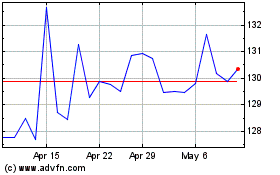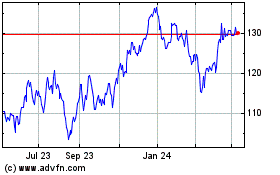Fall in Copper Prices Threatens to Drive Metal Shortages
August 09 2019 - 4:47PM
Dow Jones News
By Amrith Ramkumar
The recent slide in copper prices threatens to limit investment
in new mines, a trend that industry analysts and executives say
could lead in coming years to sizable shortages of the material
critical to manufacturing and renewable-energy projects.
Prices fell to two-year lows recently on fears that trade
tensions will weaken the global economy and crimp demand. Because
copper is heavily used in construction and manufacturing, its price
movements are closely tied to momentum in the world economy, and
particularly in China, which accounts for about half of global
demand.
Some investors say the downturn in prices could actually lead to
an even bigger rally years from now because of the time needed to
extract metal from new projects. Many of those mines also require
capital commitments to finish and are located in risky operating
jurisdictions around the world.
Ore grades also decline over time, potentially leading to lower
usable supply than expected as demand from electric vehicles and
new technologies is likely to ramp up in the mid-2020s, analysts
say.
Copper is now about 14% below the $3-a-pound level that
investors say makes many long-term projects viable. It last closed
above that level in June 2018, when President Trump approved
tariffs on about $50 billion of Chinese imports.
"We have this great inventory of opportunities, but like other
projects in the industry, they require prices higher than today's
price to develop," Richard Adkerson, chief executive of copper
miner Freeport-McMoRan Inc., said in an interview. "If global
growth turns down, then we won't be in a position to invest in
these resources."
Copper fell to $2.54 a pound on Monday, its lowest level since
May 2017, before rebounding to $2.58 on Friday.
Jefferies projects a 1 million metric ton deficit in 2024
without more capital commitments from miners. Commodities
consultancy Wood Mackenzie recently forecast a roughly 4 million
metric ton supply gap by 2028, based on annual production of about
25 million metric tons at that time.
Driving those projections is a belief that copper will be
critical to long-term shifts toward electric vehicles and cleaner
technologies in transportation and energy storage. Electric and
hybrid cars use more copper than conventional vehicles, and
analysts project hefty demand increases from the implementation of
EV charging stations. Fast-growing countries such as India also are
expected to continue investing in copper-intensive infrastructure
projects.
Another reason some investors remain confident that prices will
eventually rebound: Operating mines in places such as Indonesia
continues to come with a high degree of risk.
Many expect Freeport-McMoRan's success in the coming years to be
defined by its ability to transition a giant copper and gold mine
in Indonesia into an underground operation. Late last year, the
Indonesian government took a 51% stake in the mine -- Grasberg --
by paying nearly $4 billion to Freeport and Australian miner Rio
Tinto PLC. While the transition underground continues, Freeport is
posting lower revenue and higher capital costs.
In another sign of the challenges facing miners, Rio Tinto last
month said it will take much longer than expected and cost more to
complete a mine in Mongolia's southern Gobi Desert.
The difficulties ahead for industry leaders Freeport and Rio
Tinto could portend delays in the years ahead for other companies
pursuing complicated projects, analysts say. While there are
plentiful opportunities in countries such as Chile and Australia,
extracting the metal could prove trickier than expected.
"These projects take a long period of time to bring on line,"
said Christopher LaFemina, a metals and mining analyst at
Jefferies. "The market should be very, very tight as long as we
don't have a recession."
Still, many investors say it is difficult to invest in the metal
and shares of companies that produce it as trade uncertainty
continues to hammer copper prices. They have fallen 13% from a peak
in April. Shares of Freeport are down 36% in the past year
following a nearly 4% drop on Friday. Other mining stocks such as
Southern Copper Corp. have also taken a beating.
Hedge funds and other speculative investors pushed net bearish
bets on copper to their highest level since November 2016 during
the week ended Tuesday, Commodity Futures Trading Commission data
show.
"Investors continue to be reticent about our sector," Mr.
Adkerson said. "That's likely to be the case until there's some
clarity on the direction of this trade issue."
To receive our Markets newsletter every morning in your inbox,
click here.
Write to Amrith Ramkumar at amrith.ramkumar@wsj.com
(END) Dow Jones Newswires
August 09, 2019 16:32 ET (20:32 GMT)
Copyright (c) 2019 Dow Jones & Company, Inc.
Rio Tinto (ASX:RIO)
Historical Stock Chart
From Mar 2024 to Apr 2024

Rio Tinto (ASX:RIO)
Historical Stock Chart
From Apr 2023 to Apr 2024
